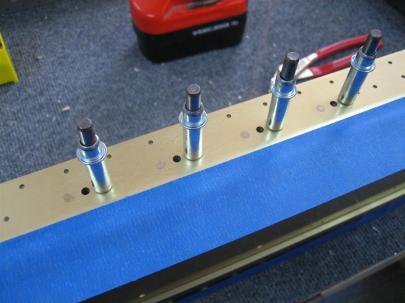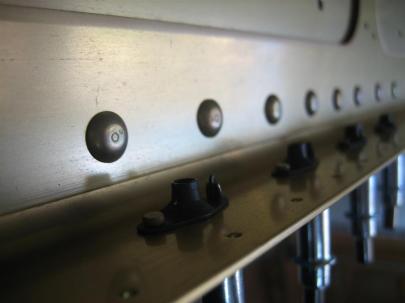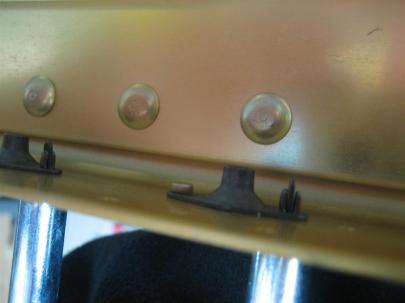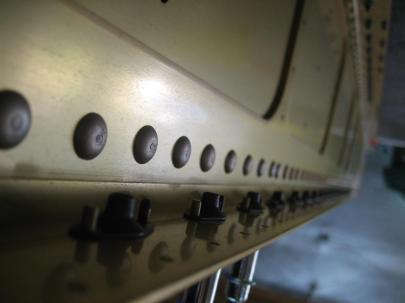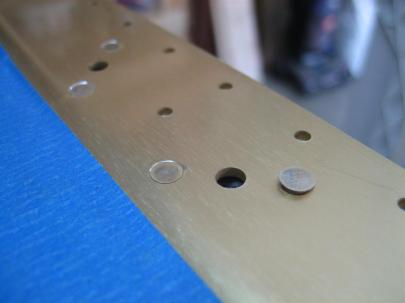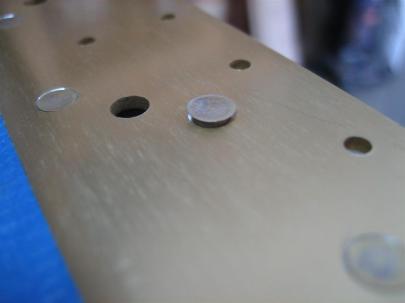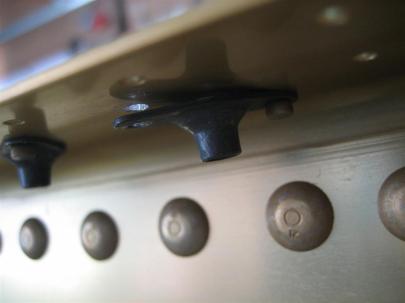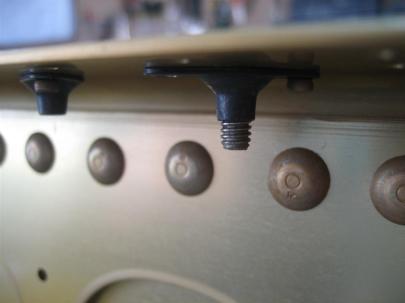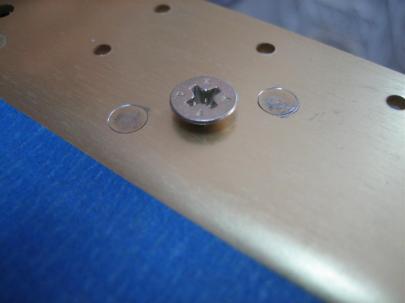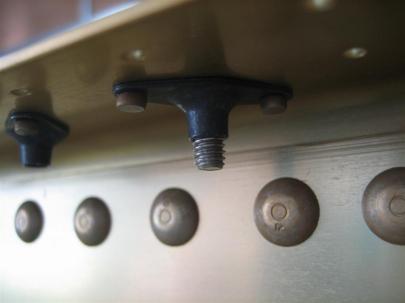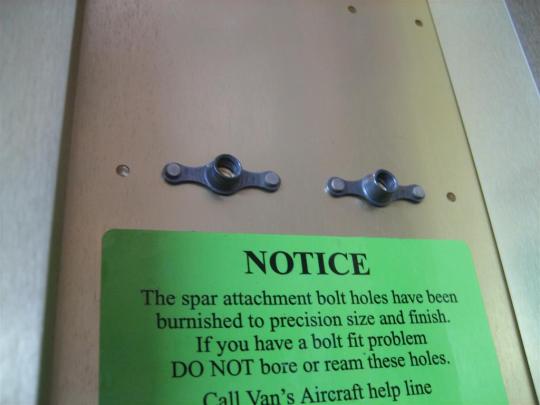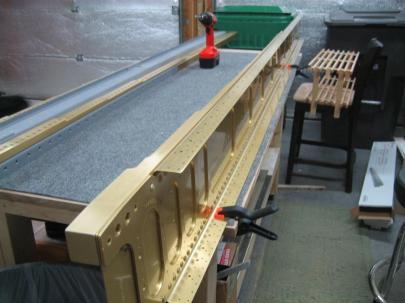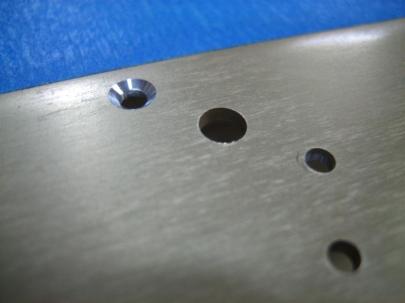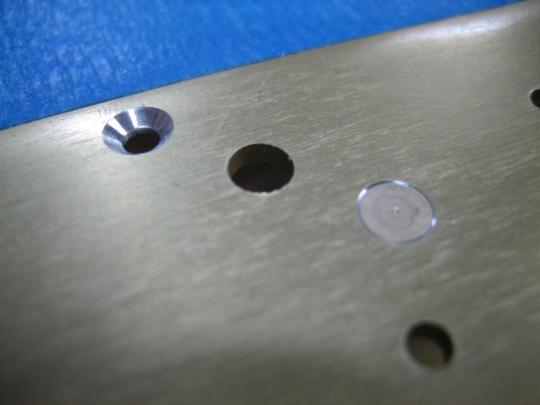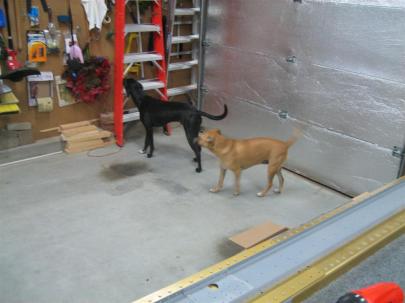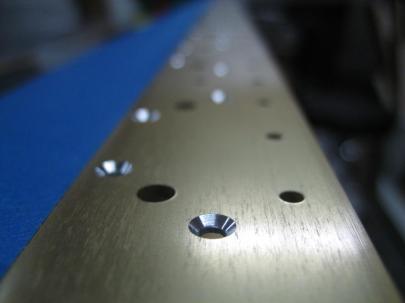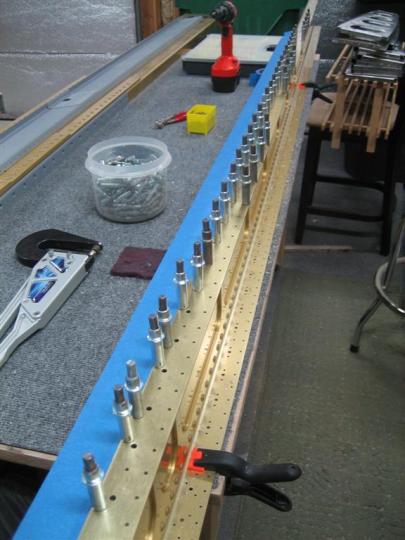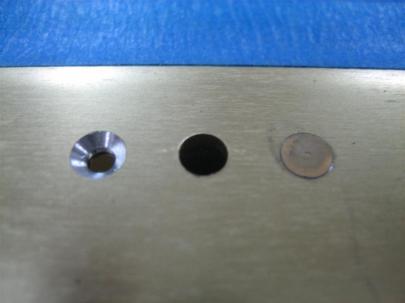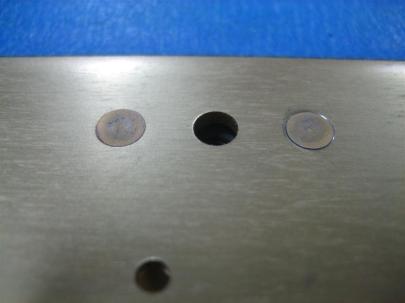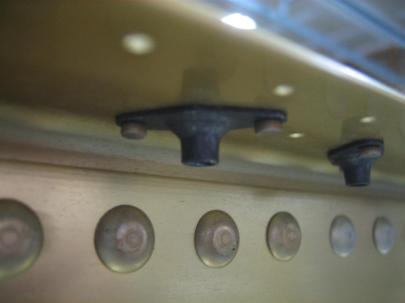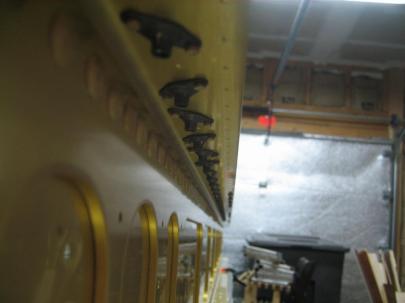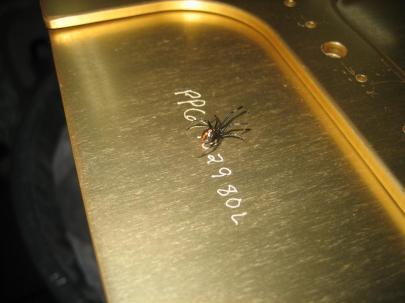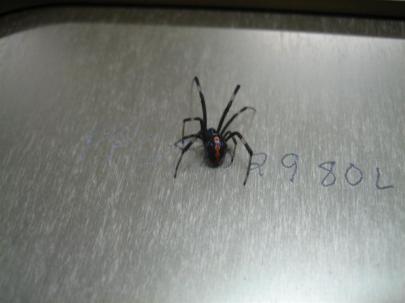Prev | Next
Well, after some thought, and inspiration from watching the VAF thread on cheap in-ear headset alternatives, I decided to sacrifice my cheap backup headset (and about $15 from Radio Shack) and try my hand at this in-ear headset thing.
My mom got me these really nice in-ear headphones for my birthday last year (thanks, Mom!), and I’m going to design this thing around those.
I’ve done a ton of research, but still feel a little uneducated. After finishing, I feel much better.
I started at Cozy1200.com, then moved on to wikipedia to teach myself about TRS connectors, audio-taper potentiometers, and then audio output transformers.
Okay, now that you are an electronics expert, read on.
Here’s everything I got from Radio Shack. Since I’m sacrificing an existing headset, I didn’t need the jacks, plugs, and microphones from aircraft spruce or anything.
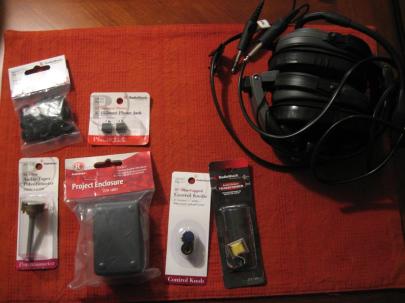
Christmas in February. Total cost ~$15.
Upper left is assorted grommets – $2
Right from there, two stereo 1/8″ panel-mount jacks – $3
Lower left is a 5K Ohm audio-taper potentiometer – $3
Then a 3″x2″x1″ project enclosure (perfect size) – $2.50
Then two 1/4″ knobs (for the potentiometer) – $2
Then an audio output transformer – $3
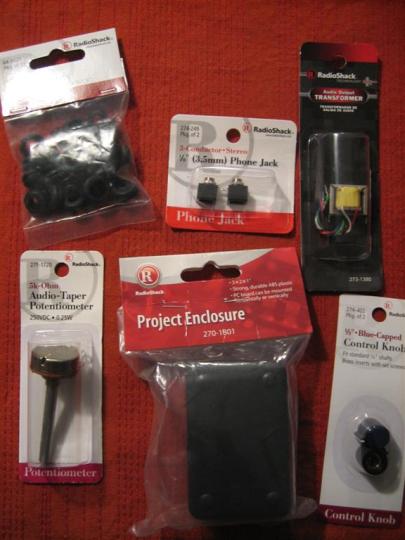
A little closer shot so you can see things more clearly.
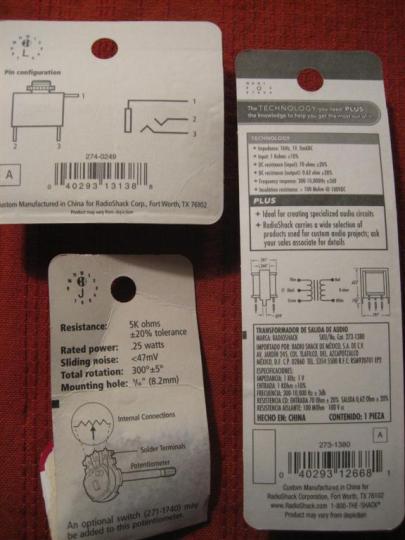
The back of some of the packaging. None of this information was helpful.
Okay, let’s get to sacrificing!
I peeled off the ear cups of my old headset, pulled back some foam, and saw a couple screws.
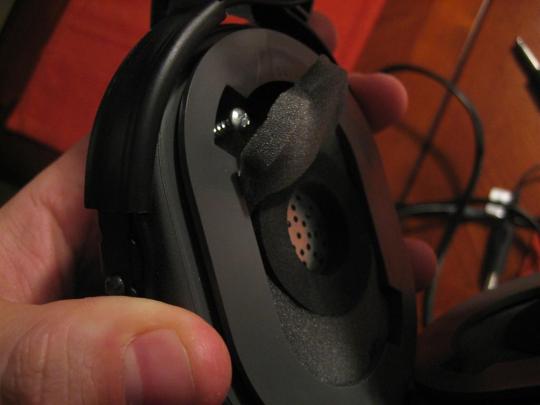
I was trying to make this non-permanent in case the project didn't work out, so I'm trying to be really careful.
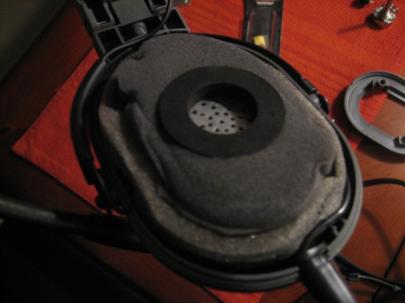
Plastic cover off.
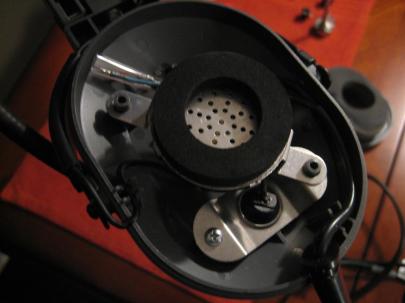
Pulled out the foam.
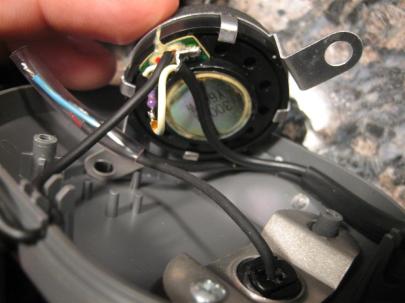
Then lifted the speaker.
The source electrons are coming in from the cord on the right. One conductor pair connects to the micrhone wires and goes back to the bottom right, which is an exit for the mic boom. The other pair goes through a resistor on the speaker and then on to the speaker in the other ear cup.
Since I am using my nice audio headphones, I don’t need to worry about the speaker stuff.
I carefully marked the microphone wires and heated up the soldering iron to start taking stuff apart.
After getting the wires disconnected, I unscrewed the retaining plate (lower right corner of the previous picture) and took apart the little plastic ball that holds the boom in place.
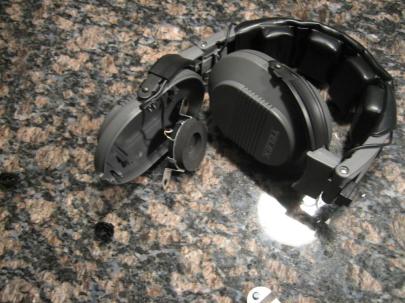
Headset with no more connections.
Sweet. Now I have what I need, the mic, boom, and cords that go to the proper aviation style jacks.
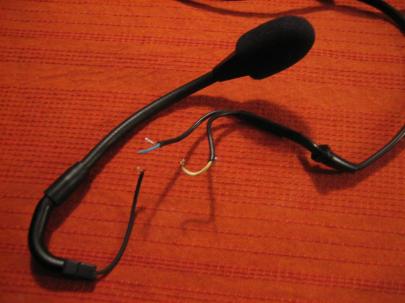
Green plus shield is for mic, yellow plus shield is for speakers.
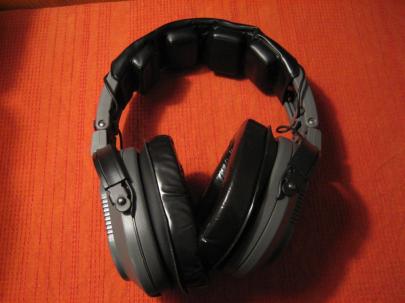
I put the headset back together so I could still use it for noise attenuation.
I had this grand plan to not even touch the mic wire. I’d just let it run straight through the project enclosure.
I stripped a little covering off of the wiring run and tried to figure out which wire to cut.
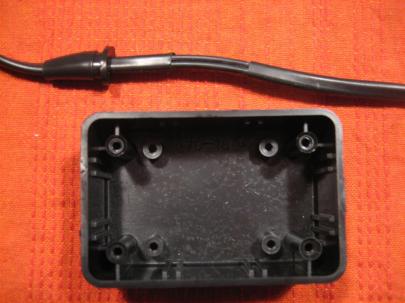
This is going to work great.
Then, I proceeded to find the mic wire, run my finger down to my now stripped wire run, and…
CUT THE WRONG WIRE!!!!!
Ugh.
So, I went ahead and cut both.

Here's what they look like up close.
Before I get too far with wiring, I need to figure out how this potentiometer works.
First, I hooked up my multimeter across the two outer terminals, and it read 4.65 KΩ no matter what the position of the pot.
Then, I hooked up my multimeter across the left and center terminals, and it read 0.00 KΩ when turned counter clockwise and 4.65 KΩ when turned counter clockwise. (I want a lot of resistance (no signal) when it’s turned counterclockwise).
Sure enough, when I hooked it up to the right and center terminals…
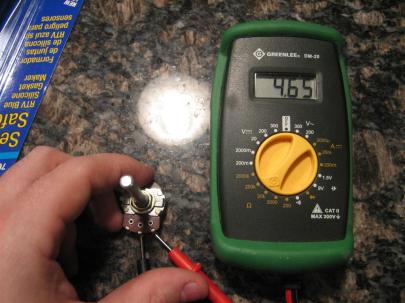
...4.65 KΩ when turned counter clockwise...
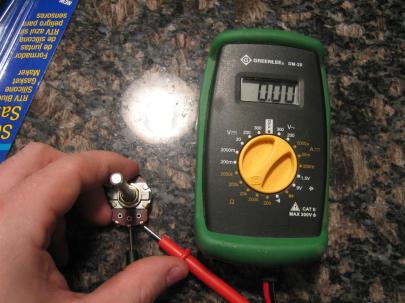
...and 0.00 KΩ when turned clockwise.
Now, let’s attach the knob.
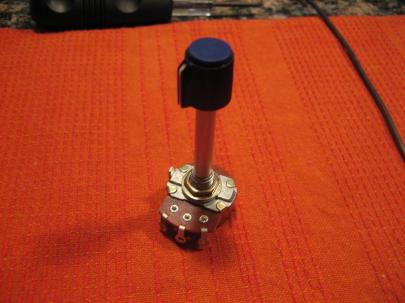
Umm... down in front?
I took it out to the garage and did a little metal removal.
Then, back inside to drill a few carefully place holes in the project enclosure.

It's a hole!
Okay, I’ve thought carefully how I want this laied out. I’m going to lay this thing on it’s edge to the left of my left thigh when flying.
So, the volume knob is on top, the wires going to the plane jacks can go forward (or aft, because the knob turn direction is constant no matter which way the box is rotated), and the microphone and headphone jack will be on the other side.
Clear as mud?
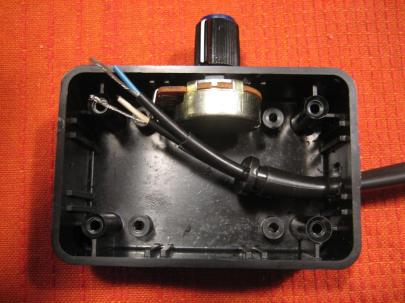
There's the knob on the potentiometer. (It barely fit).
Then, I pulled out some of the other parts. Here’s my stereo 1/8″ (phone) jack that works with most headphone plugs.
Note: My original headset is mono, so instead of pulling apart the plugs to make it stereo, I’m going to make a mono version to make sure this all works out okay. If it works well, I may try again, this time in stereo (with some music inputs, perhaps?).
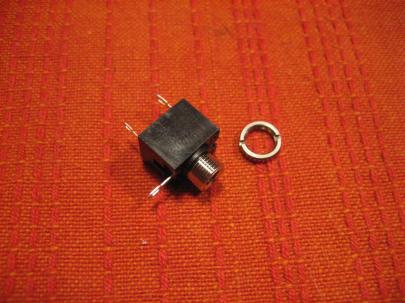
Stereo jack.
Okay, then I moved on to this really weird critter, the audio output transformer.
Without going into too much detail, there is a primary side which connects to the high impedance part of your circuit, and a secondary side, which connects to the low impedance side.
I looked at my proposed audio panel (GMA 240) and it’s output is rated at 150Ω impedance. I looked up my Klipsch headphones, and they are 18Ω impedance. I looked at my trusty David Clark headset (which seems to work great in every airplane) and it is 300Ω per speaker, or (since they are wired in parallel), 150Ω total impedance.
So I need to bump the 150Ω down to 18Ω.
“But Andrew”, you say, worriedly. “You bought a 1000Ω to 8Ω audio output transformer!!!!”
Yes, but (from my quick conversations with some of our avionics guys) the transformer is really a ratio thing.
Let’s say I just plugged my headphones into the jack. Since they are such low impedance, the audio coming from the panel would overdrive my headphones (because it’s putting enough power out for a higher impedance speaker). I’d turn the radio down so far for a correct volume that the guy (or girl) in the other seat wouldn’t be able to hear anything.
Really, it’s more important that the headphones are matched impedance, within reason of the audio output.
Anyway, if I bump down the 150Ω by a ratio of 1000/8, it would be something like 1.2Ω. That’s no good.
Based on the back of the transformer packaging, I tested the Primary side (the one with green, black, and blue wires) of the transformer for DC resistance. It was supposed to be 70Ω.
When I tested the Green and Blue, it was 70Ω. When I tested the black and blue, it was 35Ω. Yes! I think I read something about this! I’ll just use black and blue and theoretically, I’ll get 150*(8/500) or 2.4Ω. Not exactly 18Ω, but better than overdriving the headphones.
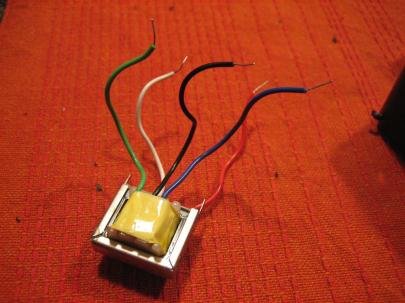
Audio output transformer, primary (1000Ω) side up.
Okay, let’s run some more wires so I can start putting this bad boy together!
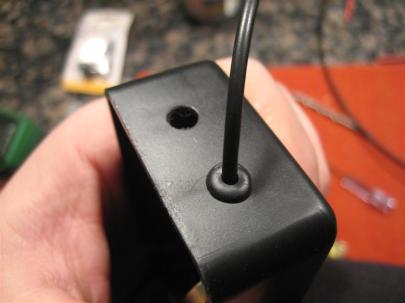
A couple of 1/4" holes for some grommets (that's the mic wire coming out) and the headphone jack.
Then, I soldered the microphone wires back together just like they were in the old headset cup.
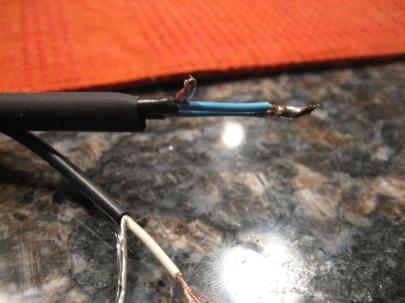
Not pretty soldering, but it will do.
Then, I hooked up the white wire from the secondary (8Ω) side of the transformer to the poteniometer.

And a little heatshrink (which has some solder on it...oops) for vibration resistance.
Then, I turned my stereo jack into a mono jack. (Remember from your wikipedia reading that tip is left, ring is right, and sleeve is ground.)
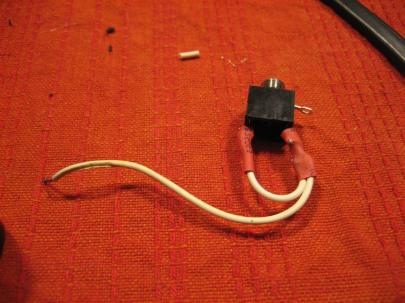
Sweet.
Then I hooked up the other wire of the secondary side of the transformer to the jack.
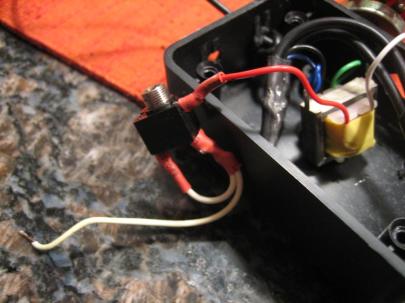
I'm getting close.
Then, the left/right side of the jack to the center connector of the potentiometer.
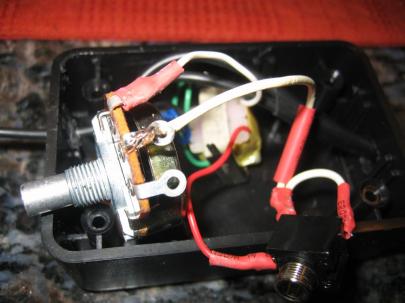
It's starting to get a little messy.
Then, very delicately mount everything and push everything into the box.

I think It's going to fit!!!
WUHOOO!
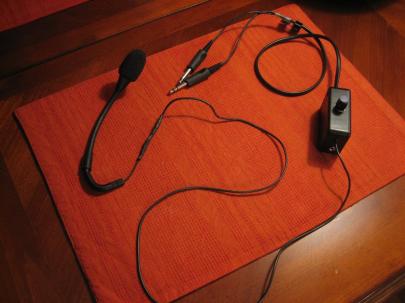
This is sweet. I can't believe I made this!
So, the existing mic from the old headset will somehow me mounted to my head (people have used heatshrink-covered piano wire, etc.), then that wire will go down, through my control box and into my audio panel through the old jacks.
My nice earbuds will plug into my control box, then go through the potentiometer (for volume) and the transformer (for impedance matching) and then to the audio panel.
As a test, I plugged my David Clarks into my home stereo system and set it to a reasonable volume. Then, I pulled in my new earbuds into my DIY headset box, then into the stereo (having turned down the volume on the box) and then slowly started raising the volume without touching the stereo system volume. When I got close to full volume, the volumes MATCHED!
WUHOOOOO!
I’m going to trust that the microphone works just like it did before, since all I did was unsolder and resolder. Now that I know the volumes match, I’m pretty sure this thing is going to work.
Tomorrow at work I’ll plug them in and see how it works.
Someone’s going to need to give me a ride in their airplane so I can compare the David Clarks with the new headset. (I’m also curious to see if my Klipsch earbuds are going to be as noise-attenuating as they are normally.
Another great night! (Doesn’t count as build time, though, since it’s not RV specific.)
Prev | Next
















 Posted by Andrew
Posted by Andrew 




























































